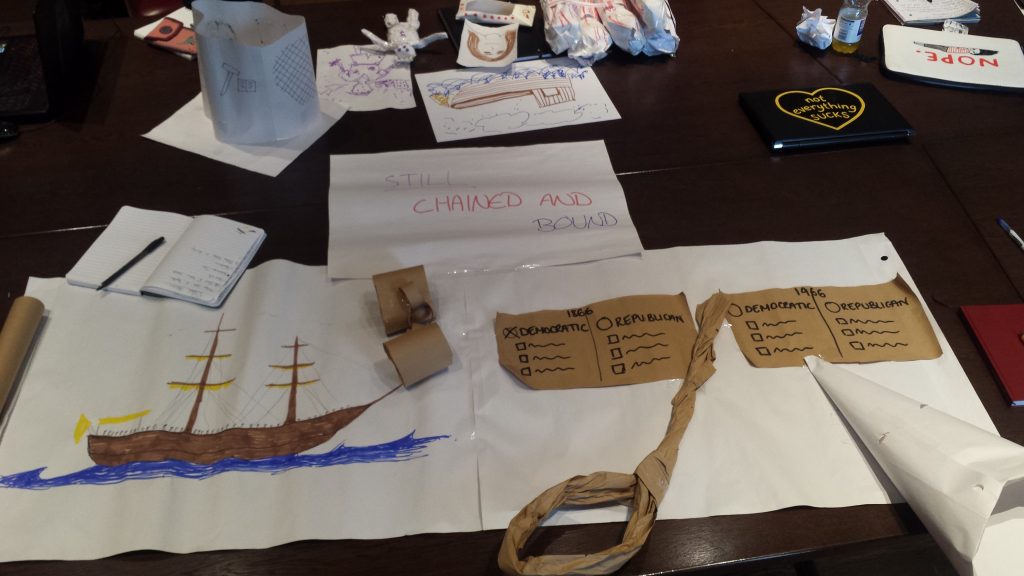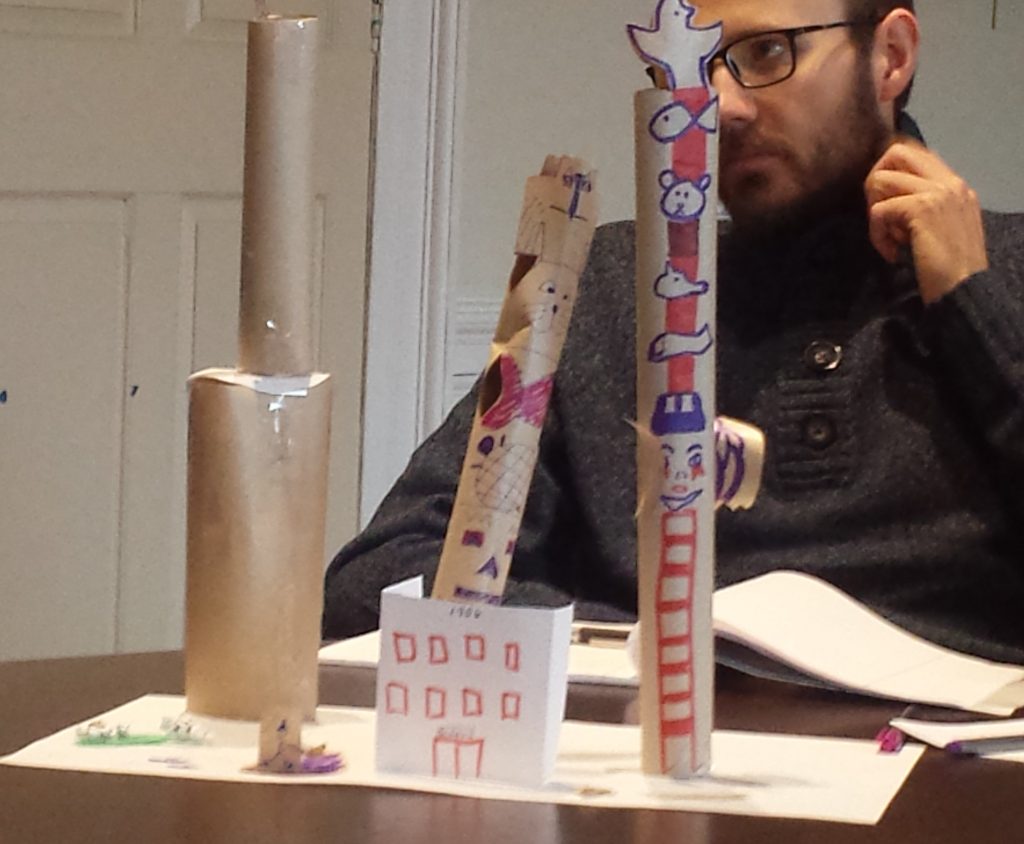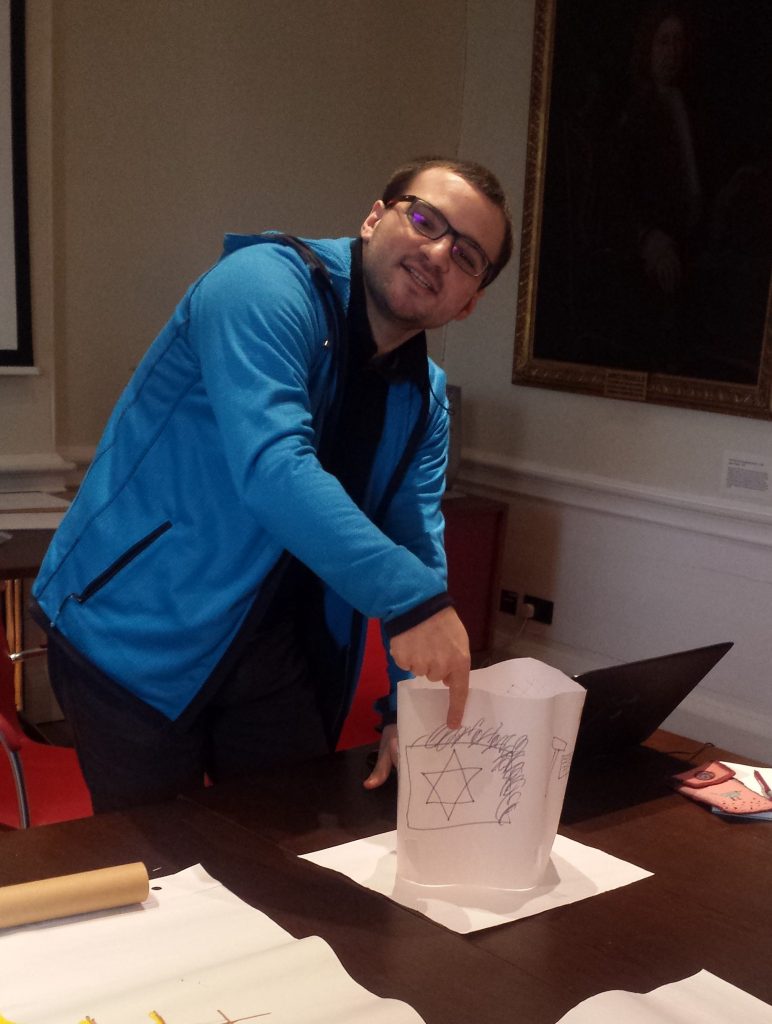Curating difficult histories is something that comes up quite often for museum staff, especially those working in museums such as the Imperial War Museum, the Holocaust Museum, or the M Shed Museum in Bristol which covers the transatlantic slave trade amongst other things. However all museums from small local authority museums, heritage centres, or multi-million pound developments will have objects that touch on sensitive topics in some respect. How the museum approaches this and displays the objects to the public is a difficult and sometimes thankless task.
The session that we had to discuss difficult histories was a group based activity where we were directed to use a selection of craft materials: card, packing paper, felt pens and crayons, Sellotape and anything we could scrounge from the craft basket in the cupboard. We were asked to use these materials to create an exhibit covering a difficult history; we could choose whatever topic we wanted but it had to be “challenging” and/or “something that makes you feel uncomfortable”.
Our group decided to create an exhibit based on the slave trade of the 19th century between Britain and the colonies. We decided that aspect we wanted to cover included: slave ships, lynching, the KKK, and emancipation. This was quite a tricky brief to be whipped up out of coloured pens and A3 paper but we were up for the challenge and certainly ran with the brief of “feeling uncomfortable”.
I used to be quite artistic (see posts past) and took on the challenge of drawing a 19th-century slave ship even though I didn’t really know what they looked like. Fortunately with ubiquitous smart phones I was able to find a decent picture to copy from Google. Obviously using felt tips and my wrong hand I couldn’t quite convey the horror of a ship packed to the gunwales with frightened slaves chained below decks or the stench of hundreds of unwashed bodies crammed into tiny spaces for weeks on end. I can’t recall ever having visited an exhibit on slavery and would be interested to compare my experience with the method used by “proper” museums to convey these aspects to visiting public.
As we were supposed to be making uncomfortable imagery we also made a noose from twisting the stout brown packing paper provided, and rolled up a cone of white paper to form a KKK hat complete with eye holes (although to be honest it looked more like a dunce’s cap to me). It was interesting that although we were talking animatedly while we made these things when they were finished and attached to the backing paper for our exhibit we all stop talking the same time and looked vaguely uncomfortable as we surveyed our handiwork.

The overall narrative was difficult to explain in such a limited format but I think it came across reasonably well and the other groups appreciated what we had tried to create and understood the points that we were attempting to make. As groups we were asked to circulate around the different exhibits before coming together for group discussion on curating difficult histories.
One group had also used the topic of slavery although they had approached it slightly differently to us (see pictures). The other two groups had roughly similar ideas. The first group worked with the concept of displacement and modern refugees while the second group covered the removal of Native American children from their families to boarding schools in Canada where they were taught “civilised” ways.



The group that dealt with the forced resettlement of Native American children was very interesting for me as I did not know anything at all about this. While I have seen the statue of the Duke of Sutherland I did not realise that he was responsible in part for the majority of the Highland clearances; as someone who grew up on the south coast of England the clearances did not factor greatly in my understanding of British history as unsurprisingly, our history education was somewhat Anglo centric. When I look back on my memories of learning history at school it seemed like all we ever did was crop rotation, Tudors and Stuarts, or the Nazis. I was moved enough by this groups presentation to do a little research outside of class and found a good article that summed up many of the aspects of this tragedy. It must be one thing to present this kind of material to a group Museum students in Scotland, and another to make an exhibit on the subject to be shown in areas that have a strong local connection to forced resettlement. I think for me this session really brought home how much cultural sensitivity is required of exhibition staff in modern museums.
